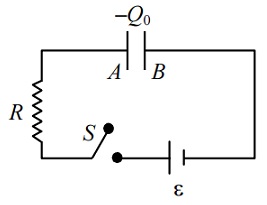Q.
The figure shows an $RC$ circuit with a parallel plate capacitor. Before switching on the circuit, plate $A$ of the capacitor has a charge $-Q_{0}$ while plate $B$ has no net charge. If at $t=0$ , the switch is closed then after how much time (in seconds) will the net charge on plate A becomes zero?[Given: $C=1μF$ , $Q_{0}=1mC$ , $\epsilon =1000 \, V$ and $R=\frac{2 \times 10^{6}}{ln 3}\Omega$ ]

NTA AbhyasNTA Abhyas 2022
Solution:
